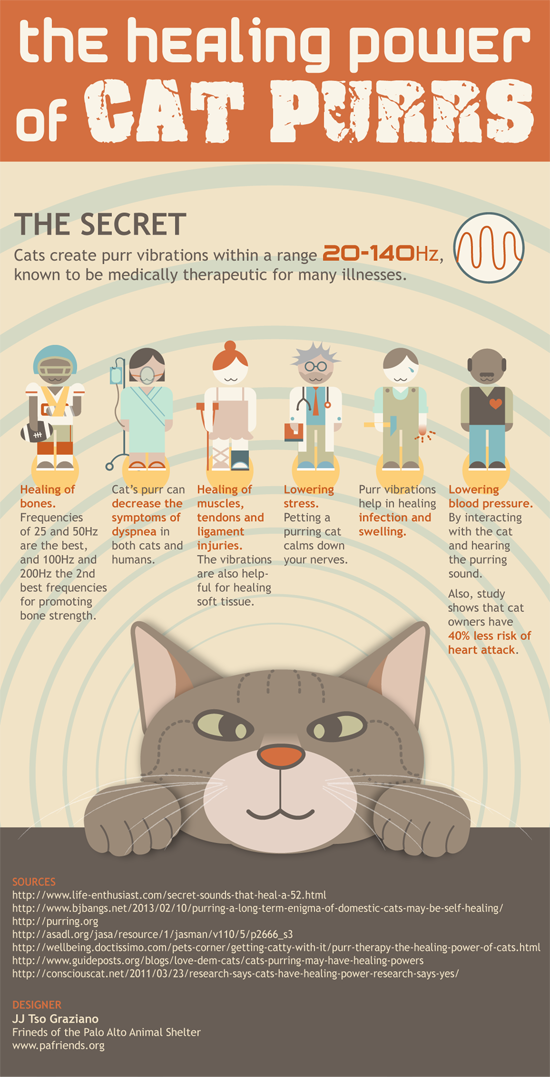
 About the Author
About the AuthorJJ Tso, our Director
The post The Healing Power of Cat Purrs appeared first on Friends of the Palo Alto Animal Shelter.
]]>The post Buster Posey appeared first on Friends of the Palo Alto Animal Shelter.
]]> My family adopted a sweet Orange Tabby from Palo Alto Animal Services in 2010. The day we were able to bring our cat home the Giants were in the World Series, so we decided his name had to be Buster Posey. Buster is a very loyal, loving cat with lots of character. Buster loves his family and especially my son, Jake. When Jake is outside playing, Buster Posey follows him where ever he goes, participating in the two square or basketball game, which essentially means lying right in the middle of the court. He has very little fear of being trampled by feet or hit with the ball, which happens from time to time. He will chase a stray ball down the street as if to make sure it doesn’t get too far away from my son and his friends. He loves children and loves to be petted by any child who walks by the house.
My family adopted a sweet Orange Tabby from Palo Alto Animal Services in 2010. The day we were able to bring our cat home the Giants were in the World Series, so we decided his name had to be Buster Posey. Buster is a very loyal, loving cat with lots of character. Buster loves his family and especially my son, Jake. When Jake is outside playing, Buster Posey follows him where ever he goes, participating in the two square or basketball game, which essentially means lying right in the middle of the court. He has very little fear of being trampled by feet or hit with the ball, which happens from time to time. He will chase a stray ball down the street as if to make sure it doesn’t get too far away from my son and his friends. He loves children and loves to be petted by any child who walks by the house.
 When things are calming down at night and my son is ready for his nightly bath, Buster begins his next favorite activity, which is teasing the neighborhood beagles. He climbs on our neighbor’s rooftop to wait for the beagles to notice his presence. Once they do, Buster’s fun begins. As the poor beagles go crazy running back and forth barking, Buster very condescendingly stares down at the beagles as if to say, “You can’t touch this”! If he could stick out his tongue and say “nanny nanny” he sure would. It’s not only beagles he teases, it’s any dog that he feels deserves a little torment. He will sit on fences or in front of windows in our neighborhood and watch these poor little dogs go crazy barking in an attempt to get a piece of Buster, which will never happen. I can almost see a smug grin on his face when he is home for the evening after a successful night of canine teasing.
When things are calming down at night and my son is ready for his nightly bath, Buster begins his next favorite activity, which is teasing the neighborhood beagles. He climbs on our neighbor’s rooftop to wait for the beagles to notice his presence. Once they do, Buster’s fun begins. As the poor beagles go crazy running back and forth barking, Buster very condescendingly stares down at the beagles as if to say, “You can’t touch this”! If he could stick out his tongue and say “nanny nanny” he sure would. It’s not only beagles he teases, it’s any dog that he feels deserves a little torment. He will sit on fences or in front of windows in our neighborhood and watch these poor little dogs go crazy barking in an attempt to get a piece of Buster, which will never happen. I can almost see a smug grin on his face when he is home for the evening after a successful night of canine teasing.
He is a great cat and a great companion for my family. We are lucky to have such a wonderful kitty!
The post Buster Posey appeared first on Friends of the Palo Alto Animal Shelter.
]]>The post Positive Reinforcement Training: People are not rational, but dogs are appeared first on Friends of the Palo Alto Animal Shelter.
]]>I often buy plane tickets up to a year in advance. Within that year, something almost always comes up that causes me to change my plans. Then, I have to buy new plane tickets or pay outrageous prices to change my ticket. I should buy the $20 travelers insurance offered to me, but I never do. I am aware of this problem, yet I do not change. I am not always rational.
You probably did not even need this example to know that people are often not rational. But, dogs? I think they have a better track record with rationality than us humans. Dogs do what works and do not do what does not work. If barking gets your attention, then they will bark. If barking gets you to ignore them, then (over time) they will learn not bark. If you responded in this way to your dog’s barking consistently, then this would be an example of positive reinforcement training .
For positive reinforcement training, you reward the positives and ignore the negatives. When your dog behaves well, you should treat, praise, provide affection or give other things your dog loves. When you dog does not behave well, you should ignore the behavior or “take away a positive.” How do you take away a positive? This does not involve punishing your dog, instead it just involves not rewarding your dog. It is often helpful to ask “what is my dog trying to get with this poor behavior?” For instance, when a dog is pulling on a leash, they are often trying to get to Point A faster. Allowing them to quickly continue to Point A is a reward. Taking away a positive would then be to (1) stop moving forward, or (2) turn around and go towards Point B instead. As a tip, I have found (2) is often easier to implement and more successful.
 We have many dogs on Wagaroo who would love to join your family and learn more positive reinforcement training. For instance, look at Sophie’s perfect sit – she needs some treats and love for that!
We have many dogs on Wagaroo who would love to join your family and learn more positive reinforcement training. For instance, look at Sophie’s perfect sit – she needs some treats and love for that!
Christine Exley, Cofounder & Chief of Research from Wagaroo
Photo Credit: State Farm
The post Positive Reinforcement Training: People are not rational, but dogs are appeared first on Friends of the Palo Alto Animal Shelter.
]]>The post Tips for Keeping Pets Safe this 4th of July appeared first on Friends of the Palo Alto Animal Shelter.
]]>When celebrating with family and friends this 4th of July, remember that fireworks and some common barbecue foods can be hazardous to the well-being of pets. The veterinary and toxicology experts at Pet Poison Helpline offer pet owners these tips for a safe and happy holiday.
“Pets are unassuming and curious,” said Dr. Justine Lee, DVM, DACVECC, associate director of Veterinary Services at Pet Poison Helpline. “Don’t let the holiday be ruined with a pet mishap. Prevention is key and taking a few simple steps can ensure a safe and happy holiday for everyone in your family, including your pets.”
Fireworks are the biggest perpetrators of 4th of July issues for pets, the most common being pet noise phobias . The loud noises can cause fear and anxiety for pets of all kinds, including dogs and cats and even horses. It is best to keep dogs and cats a safe distance from the activity – indoors is best. For pets with severe noise phobias, a veterinarian can prescribe anti-anxiety drugs or sedatives to help ease the stress. Larger pets, like horses and other livestock, are extremely susceptible to noise phobias. When in suburban and rural areas where these animals live, be considerate and contact the horse or livestock owner prior to having large fireworks displays so they can take appropriate measures to contain and reduce stress for the animals.
While most pet owners are aware of noise phobias, many are unaware that unused fireworks can be poisonous if ingested by curious dogs or cats. Many contain hazardous chemicals like chlorates, potent oxidizing agents which are harmful to red blood cells and kidneys; soluble barium salts which causes a life-threatening drop in potassium; sulfur; and coloring agents, which can contain dangerous heavy metals. Gastrointestinal issues like vomiting, a painful abdomen and bloody diarrhea can result. The severity of the reaction will depend on the type of firework, the amount ingested and what type of coloring agents it contains. In severe cases, pets can suffer tremors or seizures, along with acute kidney failure, bone marrow changes, shallow breathing and jaundice (yellowing of the skin).
During backyard fireworks shows, it’s not uncommon for fearless, unsupervised dogs to investigate flaming fused fireworks by biting into them. Obvious problems can result – thermal burn injuries to the nose, face, lips and mouth, as well as eye irritation. Emergency trips to the veterinarian are not uncommon in these situations. Avoid them by keeping pets a safe distance from fireworks – lit or unlit!
Outdoor barbecues are another age-old tradition on the 4th of July with rich savory meats, seasonal corn-on-the-cob and sweet desserts. Dogs would love to take part too, but unbeknownst to many pet owners, these common barbecue foods can make dogs sick .
Rich and fatty meats aren’t toxic to dogs and cats, but can cause gastroenteritis including vomiting or diarrhea. However in severe cases, they can cause fatal pancreatitis, especially in certain dog breeds such as miniature schnauzers, Yorkshire terriers, and Shetland sheepdogs. Corn-on-the-cob is not toxic either, but can form a severe foreign body in the dog’s intestines, resulting in vomiting and diarrhea. With corn cob ingestion, an expensive intestinal surgery may be necessary to remove the foreign mass. Other picnic dangers? Desserts made with xylitol, a natural sugar-free sweetener, or foods containing grapes or raisins can also be harmful to pets. Xylitol results in an acute drop in blood sugar and even liver failure at high doses, while grapes and raisins can result in severe, fatal acute kidney failure. It’s best not to share these foods with dogs or cats.
The post Tips for Keeping Pets Safe this 4th of July appeared first on Friends of the Palo Alto Animal Shelter.
]]>The post Venomous Creatures Poisonous to Pets in North America appeared first on Friends of the Palo Alto Animal Shelter.
]]>More than any other time of year, the spring and summer months are when Pet Poison Helpline receives more calls from pet owners and veterinarians concerning pets that have been poisoned by venom. When encountered by a venomous creature, pet owner knowledge and awareness is the best defense. For this reason, the veterinarians and toxicology experts at Pet Poison Helpline suggest that pet owners arm themselves with this list of the most common venomous creatures in North America.
Snakes
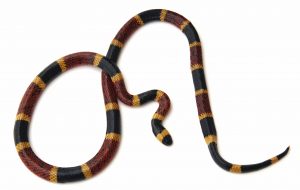 Several species of snakes are venomous and extremely dangerous to pets. Coral snakes(family Elapidae), commonly found in the Southeastern United States, are very poisonous to all pets and farm animals. The saying “red next to black is a friend of Jack; red next to yellow is a dangerous fellow,” applies to their colorful ringed bands. Coral snake venom contains neurotoxins that can cause respiratory failure and muscle paralysis. Symptoms are acute paralysis (not being able to move or walk), problems breathing, and sometimes collapsing. Treatment typically includes supportive measures, particularly respiratory. Anti-venom is effective, but not readily available.
Several species of snakes are venomous and extremely dangerous to pets. Coral snakes(family Elapidae), commonly found in the Southeastern United States, are very poisonous to all pets and farm animals. The saying “red next to black is a friend of Jack; red next to yellow is a dangerous fellow,” applies to their colorful ringed bands. Coral snake venom contains neurotoxins that can cause respiratory failure and muscle paralysis. Symptoms are acute paralysis (not being able to move or walk), problems breathing, and sometimes collapsing. Treatment typically includes supportive measures, particularly respiratory. Anti-venom is effective, but not readily available.
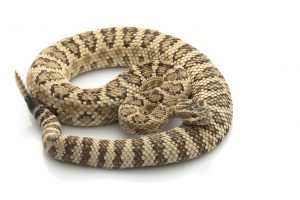 Rattlesnakes (family Viperidae) are most common in the Southeast and Southwest, but can be found in nearly all areas of the country. Pit vipers (subfamily Crotalinae) and are generally considered to be the most dangerous, followed by cottonmouths (Agkistrodon piscivorus, a.k.a. water moccasins), and copperheads (Agkistrodon contortrix). Rattlesnake bites are poisonous to all pets and farm animals. Symptoms of envenomation include difficulty breathing, bruising, cardiovascular shock, and in serious cases, organ failure. Treatment often includes intravenous fluids, antibiotics, transfusions, anti-venom and blood parameter monitoring.
Rattlesnakes (family Viperidae) are most common in the Southeast and Southwest, but can be found in nearly all areas of the country. Pit vipers (subfamily Crotalinae) and are generally considered to be the most dangerous, followed by cottonmouths (Agkistrodon piscivorus, a.k.a. water moccasins), and copperheads (Agkistrodon contortrix). Rattlesnake bites are poisonous to all pets and farm animals. Symptoms of envenomation include difficulty breathing, bruising, cardiovascular shock, and in serious cases, organ failure. Treatment often includes intravenous fluids, antibiotics, transfusions, anti-venom and blood parameter monitoring.
Something to keep in mind is that about 25 percent of rattlesnake bites are “dry,” meaning that venom is not released, but immediate veterinary attention is always recommended.
Toads
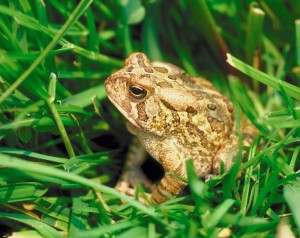 For toads, the two primary species of concern are the Colorado River toad (Incilius alvarius)and the marine toad (Rhinella marinus). Typically found in warm, tropical areas like Arizona, California, Florida, Texas, Hawaii, they are poisonous to cats and dogs. The Marine toad is considered to be the most toxic, and most dogs poisoned by them will die if untreated. Even just mouthing or holding the toad in the mouth, or drinking water from a container where the toad was laying, can result in severe poisoning. Symptoms can include severe drooling, followed by difficulty breathing, incoordination, seizures, abnormal heart rhythms, and even death. Treatment includes flushing of the mouth, medication to treat abnormal heart rates, blood pressure monitoring, and supportive care.
For toads, the two primary species of concern are the Colorado River toad (Incilius alvarius)and the marine toad (Rhinella marinus). Typically found in warm, tropical areas like Arizona, California, Florida, Texas, Hawaii, they are poisonous to cats and dogs. The Marine toad is considered to be the most toxic, and most dogs poisoned by them will die if untreated. Even just mouthing or holding the toad in the mouth, or drinking water from a container where the toad was laying, can result in severe poisoning. Symptoms can include severe drooling, followed by difficulty breathing, incoordination, seizures, abnormal heart rhythms, and even death. Treatment includes flushing of the mouth, medication to treat abnormal heart rates, blood pressure monitoring, and supportive care.
Scorpions
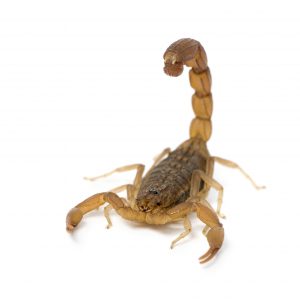 There are more than 1,500 species of scorpionsthroughout the world, but the Arizona bark scorpion (Centruroides sculpturatus) is the only species considered significantly venomous in North America. Common in the Southwest (primarily Arizona and New Mexico), it’s about 7 to 8 cm long, light brown to gold in color, and nocturnal. When dogs or cats are stung, symptoms may include drooling, itchiness, hyperactivity, seizures, abnormal eye movement, tremors, and walking in a drunk-like state. Immediate veterinary attention is recommended for pain medication, anti-venom intravenous fluids, and supportive care.
There are more than 1,500 species of scorpionsthroughout the world, but the Arizona bark scorpion (Centruroides sculpturatus) is the only species considered significantly venomous in North America. Common in the Southwest (primarily Arizona and New Mexico), it’s about 7 to 8 cm long, light brown to gold in color, and nocturnal. When dogs or cats are stung, symptoms may include drooling, itchiness, hyperactivity, seizures, abnormal eye movement, tremors, and walking in a drunk-like state. Immediate veterinary attention is recommended for pain medication, anti-venom intravenous fluids, and supportive care.
Spiders
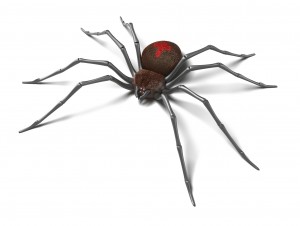 Most spiders are minimally venomous, but the female black widow (Lactrodectus) is poisonous to dogs and cats because of its large fang structure. Found throughout North America, female black widows are 2 to 2.5 cm in length, shiny and black with orange or red hour glass shaped markings on their underside. Males, generally considered non-toxic, are smaller, can be black or brown, and lack the characteristic abdominal markings. When bitten by a female black widow, dogs, and especially cats, may show signs of severe muscle pain, cramping and muscle rigidity, incoordination, tremors, paralysis, blood pressure changes, drooling, vomiting and diarrhea, and respiratory paralysis sometimes leading to death. Veterinary treatment includes the use of an anti-venom, muscle relaxants, intravenous fluids, anti-seizure medications, pain medications and symptomatic supportive care.
Most spiders are minimally venomous, but the female black widow (Lactrodectus) is poisonous to dogs and cats because of its large fang structure. Found throughout North America, female black widows are 2 to 2.5 cm in length, shiny and black with orange or red hour glass shaped markings on their underside. Males, generally considered non-toxic, are smaller, can be black or brown, and lack the characteristic abdominal markings. When bitten by a female black widow, dogs, and especially cats, may show signs of severe muscle pain, cramping and muscle rigidity, incoordination, tremors, paralysis, blood pressure changes, drooling, vomiting and diarrhea, and respiratory paralysis sometimes leading to death. Veterinary treatment includes the use of an anti-venom, muscle relaxants, intravenous fluids, anti-seizure medications, pain medications and symptomatic supportive care.
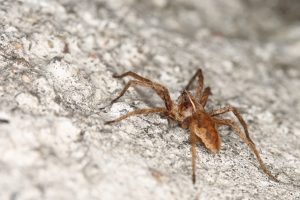 The brown recluse spider (Loxosceles reclusa)is found across the southern region of the United States. Measuring between 8 and 13 mm in length, it has long legs, ranges in shades of brown, and a violin shape on its upper body (dorsal cephalothorax). Its venom is a mix of phospholipases and proteases, which can result in severe tissue damage at the bite locations. However, there is tremendous variability of the potency and quantity of venom injected with a bite. Animals bitten may show clinical signs of vomiting, fever, lethargy, bleeding/bruising, organ damage to the liver and kidneys, severe chronic skin lesions, bleeding/bruising, organ damage to the liver and kidneys, which can lead to death. Unfortunately, no anti-venom is available for this spider. Immediate veterinary attention is always recommended, and strong supportive care measures may be needed, including wound care.
The brown recluse spider (Loxosceles reclusa)is found across the southern region of the United States. Measuring between 8 and 13 mm in length, it has long legs, ranges in shades of brown, and a violin shape on its upper body (dorsal cephalothorax). Its venom is a mix of phospholipases and proteases, which can result in severe tissue damage at the bite locations. However, there is tremendous variability of the potency and quantity of venom injected with a bite. Animals bitten may show clinical signs of vomiting, fever, lethargy, bleeding/bruising, organ damage to the liver and kidneys, severe chronic skin lesions, bleeding/bruising, organ damage to the liver and kidneys, which can lead to death. Unfortunately, no anti-venom is available for this spider. Immediate veterinary attention is always recommended, and strong supportive care measures may be needed, including wound care.
While enjoying the outdoors this spring and summer, be aware of venomous creatures native to your area and keep your pets a safe distance away. Simply keeping your dog on a leash – or your cat indoors – can minimize the chance of your pet suffering the consequences of an unfortunate encounter with a venomous creature. If your pet comes into contact with one of them, take action immediately. Contact a veterinarian or Pet Poison Helpline at 1-800-213-6680. Pet Poison Helpline is the most cost-effective animal poison control center in North America charging only $39 per call, including unlimited follow-up consultations. Pet Poison Helpline also has an iPhone application listing an extensive database of over 200 poisons dangerous to cats and dogs. “Pet Poison Help” is available on iTunes for $1.99.
The post Venomous Creatures Poisonous to Pets in North America appeared first on Friends of the Palo Alto Animal Shelter.
]]>The post Top Five Cat Toxins of 2012 appeared first on Friends of the Palo Alto Animal Shelter.
]]>Sometimes it seems like cats can defy the laws of physics. They have a keen sense of balance and nearly always land squarely on their feet, which contributes to the “nine lives” myth. But cats also have a keen sense of curiosity, which can lead them into precarious and sometimes dangerous situations. Nearly 10 percent of the calls to Pet Poison Helpline in 2012 were for potentially poisoned cats . A vast number of these cats live indoors, indicating that many cat owners are still unaware that certain items and plants lurking in their homes can be deadly to their beloved companions.
“One of a feline’s favorite pastimes is eating grass outdoors,” said Dr. Justine Lee, DVM, DACVECC, DABT and associate director of veterinary services at Pet Poison Helpline. “Indoor cats without access to grass can resort to nibbling on indoor plants, some of which can be very poisonous. Cats’ inquisitive nature, as well as their obsession with cleanliness, can also get them into trouble if they’ve made contact with a toxic substance on their coat or paws. The simple act of grooming pollen off fur after brushing up against certain types of lilies can cause severe acute kidney failure. You can avoid emergency trips to the veterinarian by understanding what items are poisonous, and keeping your beloved feline companion a safe distance away.”
Of the thousands of calls that came into Pet Poison Helpline from cat owners and veterinarians treating cats in 2012, here are the top five most common toxins that caused emergencies:
- Topical spot-on insecticides
- Household cleaners
- Antidepressants
- Poisonous plants
- Human and veterinary NSAIDS
If a cat ingests any of these things, immediate veterinary care is advised. The veterinary toxicologists at Pet Poison Helpline provide the following guidance to cat owners, including steps that can be taken to protect cats, and symptoms to watch for if cats are exposed.
Topical spot-on insecticides
Concentrated topical flea and tick medications made for dogs contain pyrethrins or pyrethroids, which are highly toxic to cats. Poisoning in cats can occur when pet owners apply dog insecticides to their cats, or when cats lick the medications off dogs. Cats can suffer severe drooling, tremors and life-threatening seizures. Always read labels carefully before using any kind of insecticide on pets and ensure it’s intended for the species you are treating.
Household cleaners
Some common household cleaners like toilet bowl cleaners, rust removers, and drain cleaners can be toxic to cats. If ingested, cats can suffer profuse drooling, difficulty breathing, vomiting, and chemical burns to the mouth and esophagus. Be sure to store these products out of cats’ reach at all times. Also, after using these products, make sure all excess liquid or residue is wiped up and dried prior to allowing your cat back into the cleaned areas.
Antidepressants
Common antidepressants such as Prozac, Zoloft, Effexor and Cymbalta can be poisonous to cats.Cats are drawn to certain antidepressants more than others, particularly Effexor, which contains a smell and flavor that is seemingly appealing to cats. If ingested, symptoms can include anorexia, lethargy, vomiting, tremors, seizures, hyperthermia, and diarrhea. While antidepressants are sometimes used in veterinary medicine to treat behavioral problems, caution should be taken, as even therapeutic doses moderate to severe clinical signs can occur.
Poisonous plants
Of all plants, lilies are the most deadly to cats. The species to watch for are the common ones – Tiger, Day, Asiatic, Easter and Japanese Show (Lilium and Hemerocallis spp.). Florists often include them in arrangements because they are fragrant, inexpensive and long-lasting. Very small ingestions of two or three petals or leaves – or even pollen licked off a cat’s coat – can result in severe, potentially irreversible kidney failure. Other “lilies,” such as Peace, Peruvian and Calla, are not true lilies and cause only minor symptoms in cats. Examples of additional household plants dangerous to cats are the cyclamen, Kalanchoe species, Dieffenbachia species, daffodils and Lily of the Valley.
Human and veterinary NSAIDS
Non-steroidal anti-inflammatories (NSAIDS) can be fatal to cats because they have difficulty metabolizing the drugs. This includes common over-the-counter NSAIDS such as aspirin, naproxen, and ibuprofen. If ingested, NSAIDS can result in severe kidney failure and stomach ulcers. Another common pain medication, acetaminophen, can also be dangerous. In fact, one tablet can be fatal to a cat. If untreated, ingestion can cause severe anemia, difficulty breathing, a swollen face, liver failure and sometimes death.
Keep your feline friends safe by protecting them from these toxins in 2013. If, however, you think a pet may have ingested something harmful, take action immediately. Contact your veterinarian or Pet Poison Helpline at 1-800-213-6680. Pet Poison Helpline also has an iPhone application with an extensive database of over 200 poisons dangerous to cats and dogs. “Pet Poison Help” is available on iTunes for $1.99.
The post Top Five Cat Toxins of 2012 appeared first on Friends of the Palo Alto Animal Shelter.
]]>The post Hartz Recalls One Lot of Wardley Betta Fish Food appeared first on Friends of the Palo Alto Animal Shelter.
]]>This Hartz Mountain recall is isolated to the following:
Wardley Betta Fish Food, 1.2-oz., UPC 0-43324-01648, lot PP06331
The affected products were shipped nationwide from May 13, 2013 through June 4, 2013 and packaged by Hartz at its Pleasant Plain, Ohio facility from a single production run. Routine sample testing conducted by Hartz as part of its quality control procedures detected the presence of Salmonella in the affected lot — PP06331.
According to the press release, Hartz is currently investigating the source of the problem.
Common symptoms associated with Salmonella poisoning include diarrhea, bloody diarrhea, nausea, vomiting, or abdominal pain. If you, your pet, or a family member are experiencing unusual symptoms, you are urged to contact a medical professional.
At the time of this release, there have been no reports of illness associated with this recall. However, Hartz urges betta fish owners who purchased this product to check the lot code, found on the bottom the container. If the container has the lot code PP06331 imprinted on it or if you are unable to decipher the lot code, immediately discontinue use of the fish food product and discard in the trash.
For further information or to obtain a refund call Hartz Consumer Affairs at 1-800-275-1414. The number will be monitored 24 hours, 7 days a week.
The post Hartz Recalls One Lot of Wardley Betta Fish Food appeared first on Friends of the Palo Alto Animal Shelter.
]]>The post Palo Alto eyes staff cuts, fee hikes at animal shelter appeared first on Friends of the Palo Alto Animal Shelter.
]]>Palo Alto Online
July 18, 2012
Read original article at www.paloaltoonline.com
Palo Alto eyes staff cuts, fee hikes at animal shelter
City unveils plan for reducing costs of popular operation by nearly $450,000
Palo Alto’s popular animal-services operation would see a slew of fee increases and staff cuts under the city’s latest proposal to keep the financially troubled division afloat.
The plan, which the City Council is scheduled to consider Monday night, July 23, aims to reduce net costs of animal services by nearly $450,000 through a combination of revenue increases and expense reductions. The financial crisis at Palo Alto Animal Services was prompted by Mountain View’s decision last year to withdraw from its partnership in the operation, a move that will deprive Palo Alto of about $470,000 in annual revenues.
Earlier this year, city officials flirted with the idea of closing the operation and outsourcing animal services but dropped this plan after overwhelming opposition from the community and, ultimately, the City Council. Last month, the council adopted a budget that includes $449,105 in cost reductions and directed staff to achieve these reductions. The fiscal crisis also spurred a group of shelter volunteers and animal activists to form a new nonprofit group, “Friends of the Palo Alto Animal Shelter,” with a mission to raise funds for the animal operation.
The [www.cityofpaloalto.org new report] from the Police Department, which oversees animal services, lays out a roadmap for filling the funding gap that resulted from Mountain View’s withdrawal. The plan calls for increasing fees for spaying and neutering by an average of 22 percent for residents of Palo Alto and its partner cities, Los Altos and Los Altos Hills. For non-residents, who make up about three quarters of all customers, the fees would be raised by an average of 50 percent. According to a report by Ian Hagerman, the police department’s performance auditor, an average cost of all spay and neuter surgeries at the shelter would be about $95 for residents and $125 for nonresidents.
“These individuals from outside of Palo Alto or our partner cities who receive service through the spay and neuter clinic would see the most dramatic fee increases, but the costs for these increases are still substantially lower than private veterinarian rates and competitive with other local low-cost providers,” Hagerman wrote.
The city’s animal shelter on East Bayshore Road would also extend its hours with the expectation of booking an additional 3,000 appointments every year, a 25 percent increase. These moves are expected to increase the revenues from the spay-and-neuter operation by $131,810 in the current fiscal year and by $143,793 every year after that.
The changes to the spay-and-neuter operation are by far the largest, though not the only, component of the city’s plan to inject revenues into animal services. The city also plans to increase most vaccination rates by $5 and dog-licensing rates by $2 to $5, depending on the type of dog and duration of the license. Adoption fees would go up by 25 percent for all customers. Rabies vaccines would remain at the current level, according to the new report.
As expected, the staff proposal also includes staffing changes, though these changes aren’t as drastic as ones the city had previously contemplated. The 13-person staff would see a reduction of 2.6 full-time-equivalent positions. These include the animal-services supervisor and one of four animal-control officers. The city also plans to slash the part-time volunteer-coordinator position with the hope that its duties could be taken over by volunteers.
The loss of an animal-control officer would likely reduce response times in some instances, particularly when there are simultaneous calls for services. This impact, however, would be slightly mitigated by Mountain View’s withdrawal from the local operation. Daily calls for services are expected to drop by about 10 per day to seven or eight between November and April and to decline from 13 to about 10 during the busier period of May to October.
“This reduced level of calls will offset some of the impact of the position eliminations, but could still result in days where lower priority calls, such as deceased animal pickups, experience a delayed response and could be held over for the following shift during particularly busy days,” Hagerman’s report states.
The proposed staffing reductions are expected to save the city $284,426 annually starting next year.
Altogether, the cost reductions would constitute about 60 percent of the funding gap while the revenue increases would make up the other 40 percent.
The changes in Animal Services, while significant, would have been far more dramatic if not for a series of donations from local volunteers and from Santa Clara County, which included a $47,000 allocation for the shelter in its recently approved budget.
The city also received a $35,000 contribution from an anonymous donor for the purpose of keeping the volunteer-coordinator position around for the coming fiscal year. Because of this donation, the city doesn’t peg the position for elimination until fiscal year 2014.
The post Palo Alto eyes staff cuts, fee hikes at animal shelter appeared first on Friends of the Palo Alto Animal Shelter.
]]>The post Surprise $47K for Palo Alto Animal Services from Santa Clara County appeared first on Friends of the Palo Alto Animal Shelter.
]]>Palo Alto Daily News/San Jose Mercury News
June 16, 2012
Read original article at www.mercurynews.com
Palo Alto’s cash-strapped animal services division received a much needed shot in the arm Friday.
The $4.1 billion budget passed by the Santa Clara County Board of Supervisors includes $47,000 for the division, which is facing an uncertain future after losing one of its three partners.
The one-time allocation, proposed by termed-out Supervisor Liz Kniss, represents 10 percent of the $470,000 deficit caused by Mountain View’s departure. The money is intended to help the division either develop a new operational model or fund the existing one while solutions are developed.
“Animal services are very important to the community, and in light of recent events, Palo Alto needs some time to revamp the services and budget,” said Kniss, who represents Palo Alto on the board of supervisors.
In addition to Mountain View, Palo Alto has provided animal services to Los Altos and Los Altos Hills since 1993.
News of the surprise cash infusion was welcomed by the Friends of the Palo Alto Animal Shelter, a volunteer-led nonprofit organization formed last month to ensure the division’s future.
“We really want to thank the county Board of Supervisors and Supervisor Liz Kniss for their generosity,” spokesman Luke Stangel wrote in an email to The Daily News. “The shelter is a critical asset in Palo Alto, and we’re grateful that people are willing to do whatever it takes to keep it running.”
Palo Alto City Manager James Keene initially proposed outsourcing the division to an agency like the Silicon Valley Animal Control Authority, which Mountain View voted to join last year. The move would have potentially lowered annual expenditures on animal services to $500,000.
The suggestion stirred strong community opposition and received a thumbs-down from two city council committees.
While the city council is expected to pass a budget next week that keeps the division’s $1.7 million budget intact, a stakeholders group formed by Keene at the Finance Committee’s direction is already working to find ways to cut costs and raise revenues by $500,000.
A package of fee hikes and staffing cuts will likely be presented to the city council later this year.
“This donation really came at the perfect time for the shelter,” Stangel said about the $47,000 from the Board of Supervisors. “A lot of us are trying to figure out how to create $500,000 in new revenue, and this donation essentially represents the first 10 percent of our goal.”
Kniss also proposed funding for a mammography program that serves low-income women and funding for safety-net programs operated by the Sunnyvale and West Valley community services agencies.
“Many of the programs I support focus on prevention,” Kniss said. “By investing in such services now we avoid worse prospects down the road, in both monetary and human terms, of trying to address community needs.”
Email Jason Green at jgreen@dailynewsgroup.com.
If you want to go
A fundraiser to benefit the Palo Alto Animal Services division will take place Tuesday, from 5:30 to 7:30 p.m., at Gordon Biersch Brewery Restaurant, 640 Emerson St. For more information on upcoming events, visit www.pafriends.org
The post Surprise $47K for Palo Alto Animal Services from Santa Clara County appeared first on Friends of the Palo Alto Animal Shelter.
]]>